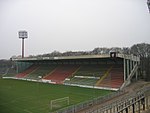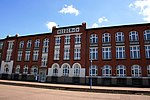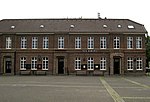Botanischer Garten Krefeld

The Botanischer Garten Krefeld (3.6 hectares), more formally the Botanischer Garten der Stadt Krefeld, is a municipal botanical garden located at Sandberg 2, Krefeld, North Rhine-Westphalia, Germany. It is open daily in the warmer months; admission is free. The garden was established in 1927–1928 as part of a small school. Today it contains about 5,000 species and varieties of plants in a plot edged with deciduous trees, shrubs, and conifers. Major garden features include a rose garden of some 3,000 specimens representing 150 rose varieties, an alpine garden, a medicinal herb garden, and a rhododendron area. Greenhouses contain cacti from South America and succulents from Africa, and other plants of the Canary Islands, carnivorous plants, and orchids.
Excerpt from the Wikipedia article Botanischer Garten Krefeld (License: CC BY-SA 3.0, Authors, Images).Botanischer Garten Krefeld
Krefelder Promenade, Krefeld Oppum
Geographical coordinates (GPS) Address External links Nearby Places Show on map
Geographical coordinates (GPS)
| Latitude | Longitude |
|---|---|
| N 51.3325 ° | E 6.6030555555556 ° |
Address
Botanischer Garten
Krefelder Promenade
47809 Krefeld, Oppum
North Rhine-Westphalia, Germany
Open on Google Maps










